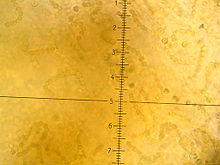| Fat choy | |
|---|---|

| |
| Nostoc flagelliforme under a microscope | |
| Scientific classification | |
| Domain: | Bacteria |
| Phylum: | Cyanobacteria |
| Class: | Cyanophyceae |
| Order: | Nostocales |
| Family: | Nostocaceae |
| Genus: | Nostoc |
| Species: | N. flagelliforme
|
| Binomial name | |
| Nostoc flagelliforme | |
| Synonyms[1] | |
| Fat choy | |||||||||||||||
|---|---|---|---|---|---|---|---|---|---|---|---|---|---|---|---|
 | |||||||||||||||
| Traditional Chinese | 髮菜 | ||||||||||||||
| Simplified Chinese | 发菜 | ||||||||||||||
| Literal meaning | "hair vegetable" | ||||||||||||||
| |||||||||||||||
| Alternative Chinese name | |||||||||||||||
| Traditional Chinese | 頭毛菜 | ||||||||||||||
| |||||||||||||||
Fat choy (traditional Chinese: 髮菜; simplified Chinese: 发菜; pinyin: fàcài; Jyutping: faat³ coi³; Nostoc flagelliforme) is a terrestrial cyanobacterium (a type of photosynthetic bacteria) that is used as a vegetable in Chinese cuisine. When dried, the product has the appearance of black hair. For that reason, its name in Chinese means "hair vegetable". When soaked, fat choy has a soft texture which is like very fine vermicelli.
- ^ a b Calvo-Pérez, Juan Diego; Molinari-Novoa, Eduardo A.; Guiry, Michael D. (23 March 2016). "Validation of Nostoc flagelliforme (Nostocaceae, Cyanobacteria)" (PDF). Notulae Algarum (2): 1–2. ISSN 2009-8987. Retrieved 15 January 2019.